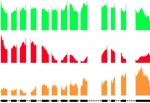We have learned about alignment and quantification of RNA-seq reads. While these steps are necessary, we really want to learn something about biology!
In Activity 4, we will see how RNA-seq helps us discover new genes and detect alternative splicing. Both functions are important for learning about how our bodies work and for treating disease.
Click on the image to view the presentation in your web browser or download the PowerPoint slide show (ppsx format). The content in each format is the same.
Discussion Questions
1. What would be a reasonable hypothesis if you had a lot of RNA reads align with a part of the genome containing no known genes?
2. RNA-seq can identify different spliceforms. What were the example diseases that can change RNA splicing?
3. How does RNA-seq allow you to see how much of one type of spliceform is expressed compared to another type of spliceform? Hint: If you have your aligned reads for the spliceforms, what would you do next to compare the two spliceforms?


 Discovering the Genome
Discovering the Genome
